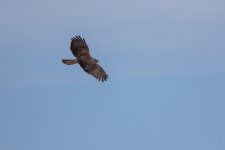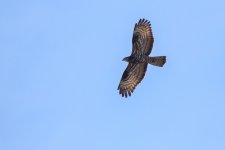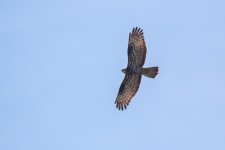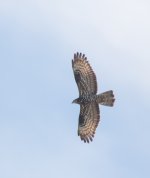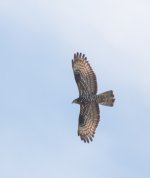-
Welcome to BirdForum, the internet's largest birding community with thousands of members from all over the world. The forums are dedicated to wild birds, birding, binoculars and equipment and all that goes with it.
Please register for an account to take part in the discussions in the forum, post your pictures in the gallery and more.
You are using an out of date browser. It may not display this or other websites correctly.
You should upgrade or use an alternative browser.
You should upgrade or use an alternative browser.
pernis apivorus or hybrid ? North West greece May 24, 2020 (1 Viewer)
- Thread starter bairakta
- Start date
More options
Who Replied?
interesting bird, my guess would be still EHB with P5 as long as it it could get, the smudgy gorget is a bit disturbing though. Send it to Dick Forsman and tell us what he thinks about it (www.dickforsman.com)
_pauls
Well-known member
Thank you Tom do you have any contact information of Dick Forsman ?
His email address is listed in the footer of the website linked by Tom above
thank you for your post but unless i am doing something totally wrong the RSS entries or comments don't seem to work at allHis email address is listed in the footer of the website linked by Tom above
RafaelMatias
Unknown member

His email address is listed in the footer of the website linked by Tom above
dick at dickforsman.com
replace "at" with @ and remove the spaces.
dick at dickforsman.com
replace "at" with @ and remove the spaces.
thank you Rafael
John Cantelo
Well-known member
I tend to shy away from hybrid theories. I'm not at all sure that it's not just an odd European Honey Buzzards but the wings do look broad so can a female Oriental Honey Buzzard (not a species with which I'm very familiar) be entirely discounted?
Andy Adcock
Worst person on Birdforum

I tend to shy away from hybrid theories. I'm not at all sure that it's not just an odd European Honey Buzzards but the wings do look broad so can a female Oriental Honey Buzzard (not a species with which I'm very familiar) be entirely discounted?
Me too, are they known to hybridise and if so, with what?

Me too, are they known to hybridise and if so, with what?
in Dick Forsman’s latest ‘Flight Identification’ guide there is a whole chapter called ‘Identification of hybrid Honey-buzzards’. They seem to be common where both EHB and OHB meet (same for GSE LSE hybrids, common as well).
Andy Adcock
Worst person on Birdforum

Thanks Tom.

It’s interesting (both birds in image 2 and 3 appear to be on the same plane) no doubt a frame or two apart and yet the wing shape differs to my eye, being more compact (looking shorter winged) in image 2. and longer winged in 3?
Cheers
I agree Ken, OHB and EHB have very different wingshape, hybrids are in between but here wingshape is different in every pic
It’s interesting (both birds in image 2 and 3 appear to be on the same plane) no doubt a frame or two apart and yet the wing shape differs to my eye, being more compact (looking shorter winged) in image 2. and longer winged in 3?
Cheers
in image 3 the bird approaches and in image 2 the bird is turning looking(there are 12 frames apart during the second circle of the birds flight it was moving circular above me ) at the camera probably the difference at the wing shape is due to the angle of the flight. the image i post here it is vertical above me
Attachments
I agree Ken, OHB and EHB have very different wingshape, hybrids are in between but here wingshape is different in every pic
it was moving circular s the angle is different between pics i just posted a fram ethat is above me
Attachments
KenM
Well-known member
it was moving circular s the angle is different between pics i just posted a fram ethat is above me
Excellent informative shots bairakta :t:
Cheers
interesting bird, my guess would be still EHB with P5 as long as it it could get, the smudgy gorget is a bit disturbing though. Send it to Dick Forsman and tell us what he thinks about it (www.dickforsman.com)
Dick Forsman's reply :
To me this looks like a normal European Honey-buzzard (EHB), an adult
female. The underwing and tail barring, the wing shape, the wing-formula
and the dark carpal patch all comply nicely with a normal adult female
EHB, and to my eyes there is nothing suggesting influence from any other
species in this bird. If someone has made a point about the slightly
protruding 6th finger, the shape and length of this primary is still
perfectly within the variation found in EHB. The 6th finger (=p5) shows
no distinct emargination along its outer web (which can be clearly seen
in the backlit images) as there should be in Oriental Honey-buzzard, in
which the feather is both longer and more clearly fingered than here.

Dick Forsman's reply :
To me this looks like a normal European Honey-buzzard (EHB), an adult
female. The underwing and tail barring, the wing shape, the wing-formula
and the dark carpal patch all comply nicely with a normal adult female
EHB, and to my eyes there is nothing suggesting influence from any other
species in this bird. If someone has made a point about the slightly
protruding 6th finger, the shape and length of this primary is still
perfectly within the variation found in EHB. The 6th finger (=p5) shows
no distinct emargination along its outer web (which can be clearly seen
in the backlit images) as there should be in Oriental Honey-buzzard, in
which the feather is both longer and more clearly fingered than here.
:t:
Users who are viewing this thread
Total: 2 (members: 0, guests: 2)




